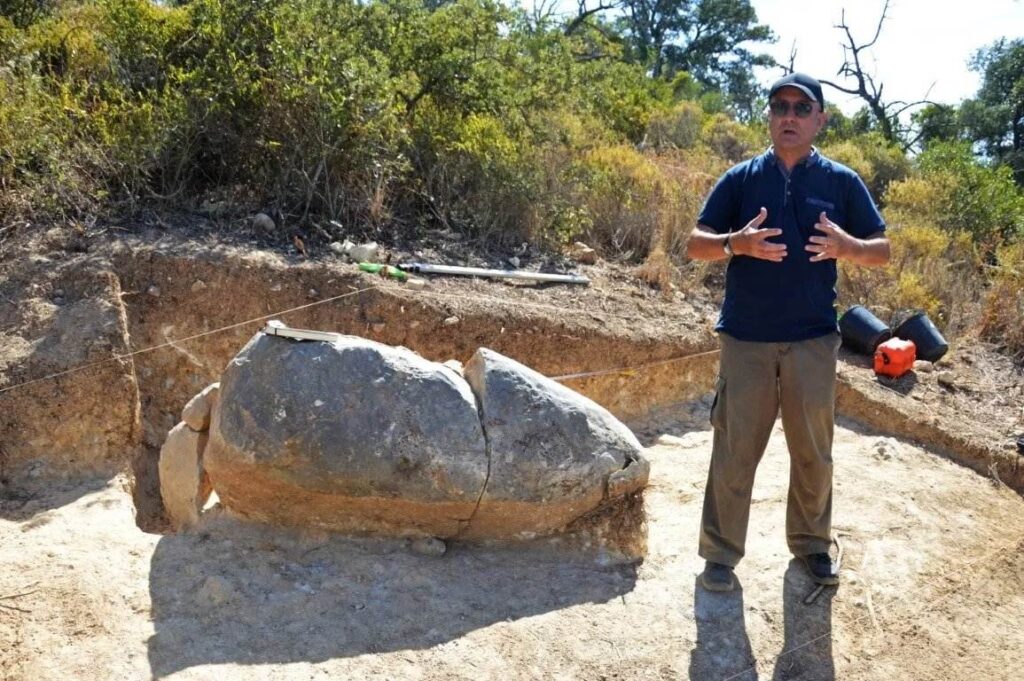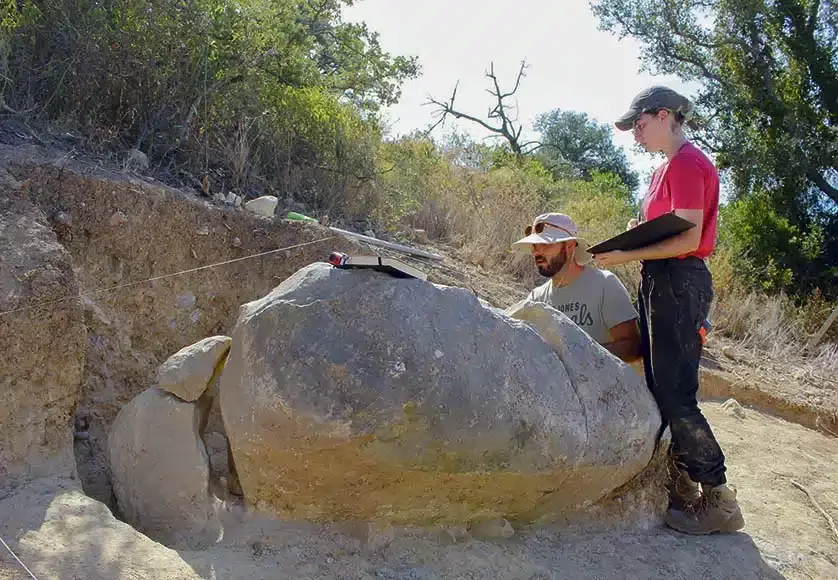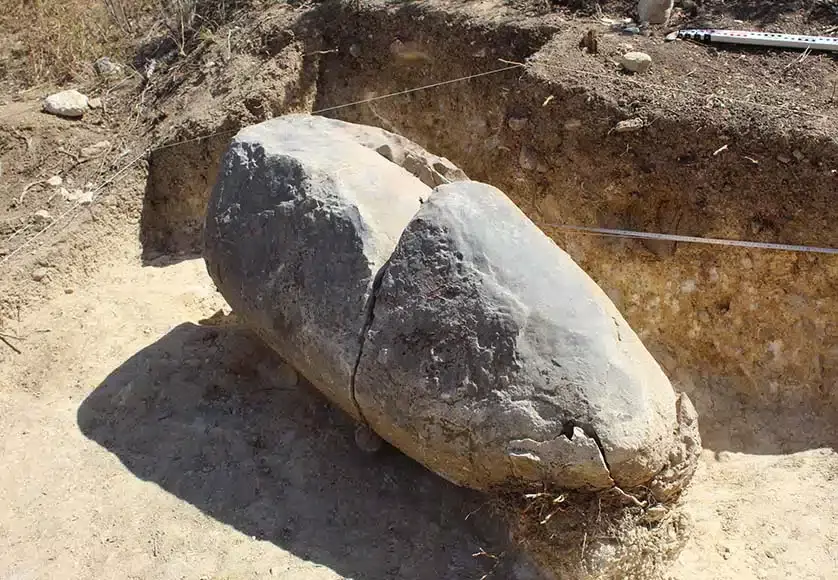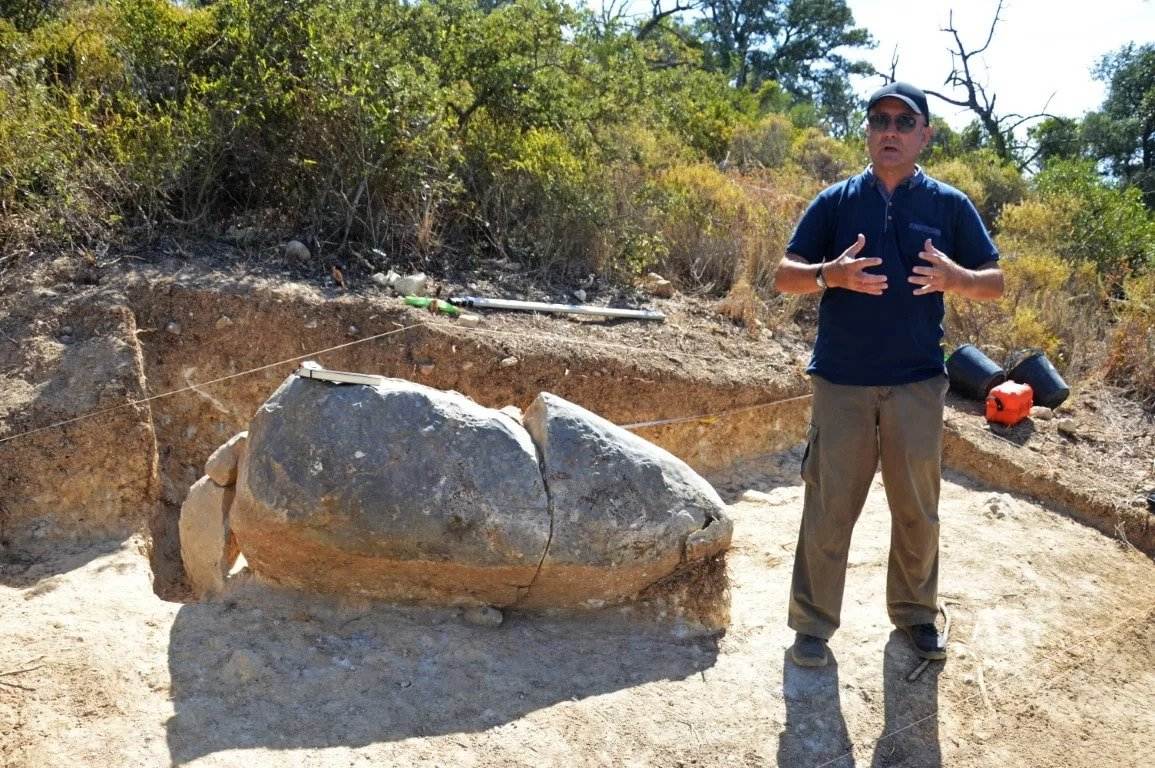5,500-year-old Menhir discovered in Portugal
Menhir found at Monte do Trigo is particularly important for East Algarve (Sotavento) and of interest on a regional scale.

The first archaeological digs in São Brás de Alportel date back to the 1870s and 1880s, when the municipality was still a parish in the Municipality of Faro. Estácio da Veiga, a pioneer of modern archaeology in the Algarve, was the first to inventory the initial findings.
A century and a half later, the first-ever archaeological excavation in the history of the municipality of São Brás de Alportel started on August 14, 2021, following the discovery of a possible menhir by a resident looking for trilobites (fossils) at the top of Monte do Trigo, in the Machados area.
The Regional Directorate of Culture of the Algarve joined forces with the Municipality of São Brás de Alportel and the University of the Algarve (UAlg).
As soon as professor and archaeologist António Faustino Carvalho came across the object, he said he was “immediately 95% certain that we were facing a menhir”, he clarified to journalists on Friday, August 18, during the presentation of the preliminary fieldwork results that ended that day.
Next to the stone monument, he explained that it is a menhir of particular importance for the Eastern Algarve (Sotavento) and of interest on a regional scale. “Its shape, the raw material it is made of (limestone), and its dimensions are the same as the dozens of menhirs from the Neolithic period that we already know of in Barlavento (West Algarve) – in Aljezur, Lagoa, Lagos, and Vila do Bispo. Outside these municipalities, we aren’t aware of any.”
“In the Sotavento, in Salir, for example, there is the Menhir of Cerro das Pedras discovered by Estácio da Veiga in the 19th century, and in Alcoutim, there is a menhir complex. But they are similar structures, made with other rocks and different compositions.
In other words, they belong to a more recent period of prehistory, the Copper Age, around 5,000 years old. This one, I would say, is around 5,500 years old and is from the Neolithic period,” he explained.

This is an important discovery “because it demonstrates that in the Sotavento, these first Neolithic communities also bear witness to their presence in the territory”.
After a week of fieldwork, researchers discovered that the menhir was not a unique piece in this location. “It is not isolated. I would say that there are three or four more pieces, but in very poor condition.
They are broken, and some are reduced to fragments of about 40 centimetres. The menhir was lucky enough to be partially covered with earth and, as it is bulky, it will have withstood, over these millennia, human action and the passing of time. Originally, it would have been vertical – we don’t know where – and it would have fallen and landed here,” said the archaeologist.
Is there a chance that it was a cromlech? Faustino Carvalho responds: “We have a lot of difficulty reconstructing that, for now. A team has started work at the top of the hill and will survey the findings. Only then, with the complete map, will we be able to better understand the arrangement of the various fragments and whether there is an alignment.
“Isolated menhirs are rare; they usually appear lined up at regular intervals since they are fundamental territory markers. In other words, they marked transit points, cattle crossings or connections between two territories belonging to different communities. We must be cautious before claiming it was a cromlech, an alignment or something else we still can’t understand.”

For the archaeologist, there is another curious aspect to highlight. “The food economy of these first Neolithic communities involved rearing cattle and cultivating the land. It is interesting to look at the micro-toponymy and the names of the surroundings.
We are on the Monte do Trigo (Wheat Hill), down there is the Vale do Joio (Darnel Valley), and we have a menhir linked to cults related to prehistoric agriculture. Here we have an allusion to the agricultural potential of this location in São Brás, which still has the same human perception,” he said.
Future of monument still uncertain
Following the fieldwork, the archaeologist believes that “we have a sufficient characterization of the archaeological reality of this site, and I believe that, in principle, unless new data appears that we are unaware of, nothing justifies the resumption of work in the next year”.
A report and topographical study will now be redacted, and the decision on what to do with the monument will be made. “We must talk among entities (Municipality and Regional Directorate of Culture). The UAlg (University of Algarve) will give its technical opinion, and I do not want to commit to my decision because we are still in discussions,” clarifies Faustino Carvalho.
Two plans have to be considered, and they are related to the object’s conservation – “Which is better? Leaving it here or exhuming it and transporting it to a protected place?” These are the questions that the archaeologist will have to answer in the final technical report. “I’m hesitating.
On the one hand, the piece is fragmented, has several chips and is cracked in half. Remaining exposed as it is, it runs the risk of being irreversibly fractured. On the other hand, if we take it from here, we have the technical problem of removing it. We are on a slope that vehicles can’t reach easily and where the menhir can break. Everything will be taken into consideration,” he explains.

For the second hypothesis, the professor suggests placing it in the Centro Explicativo da Calcinha, the “ideal place because it is a tourist attraction in the municipality, inserted in a remarkable landscape”.
Municipality wants to expand study
Vítor Guerreiro, mayor of São Brás de Alportel, who was present at the time, told journalists: “This work is very important. In the municipality, we have always prioritised valuing our heritage, studying it, getting to know it better and, whenever possible, making it available to the population. It was with great joy that we saw the work on this find.
Everything we can find that values our ancestral history is to be preserved above all else. We are completely open to following the directions of those who know best. We feel that we have to know where we come from to design a better future for everyone.
We are open to technical indications that enhance this heritage and, if possible, extend the study to this area and others because we hope to find more important archaeological finds” in the municipality.
What is a menhir?
As explained by António Faustino Carvalho, “a menhir is a stone monument, placed vertically, polished and often buffed to create a phallic shape.
They are one of the first stone monuments in human history and, in Europe, they are the first to have a religious function. No one lived, slept, or went about their daily lives around these parts, but they were places of meeting, festivities and worship, which we are largely unaware of”.
In practice, they symbolised fertility, whether of animals, people or land, hence their form. In the Neolithic period, the first farmers in human history depended on the seasons for the reproduction of animals to sow and harvest crops. “Hence the practice of worship ceremonies and the location of the menhirs, on hilltops, because we are closer to the sky,” says the professor.




